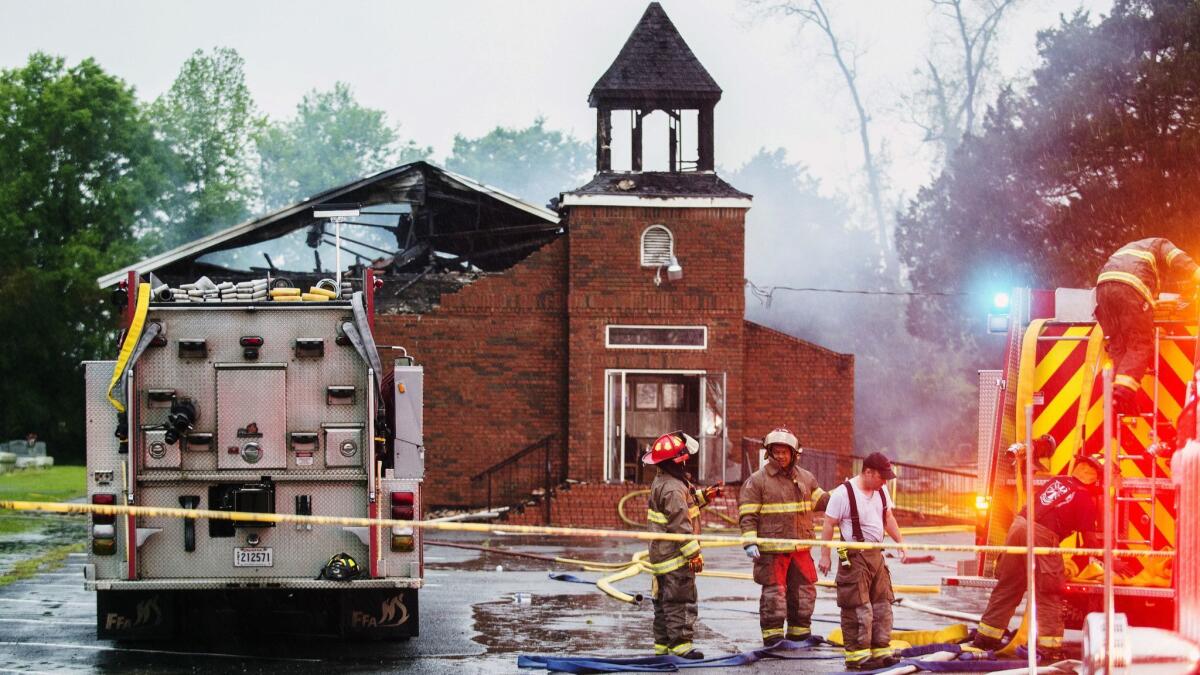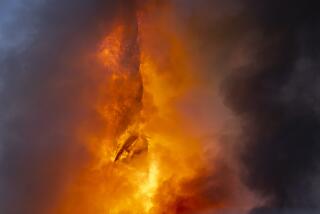Notre Dame fire inspires giving for black churches burned in Louisiana

They were modest brick buildings, without soaring Gothic spires, elaborate rosette windows or roofs carved of 12th century timber.
But the three houses of worship that burned down over the last month in a rural part of south Louisiana were longtime pillars of their African American congregations. To those who prayed there, they were no less sacred than the historic Notre Dame Cathedral in Paris.
Not that many other people saw it that way. On Sunday, a crowdfunding site for the three humble churches had pledges totaling just under $50,000.
Then on Monday, after flames consumed the roof and spire of the 800-year-old Gothic French landmark and people across the world vowed to rebuild it, calls rang out for solidarity with Louisiana.
“The rebuild of Notre Dame will be well funded,” journalist Yashar Ali said on Twitter as he promoted the fundraiser. “In the past month, three historically black churches in Louisiana were destroyed by a racist arsonist. He has been charged with hate crimes, but these churches need your help.”
By late Wednesday, the fund was nearing its goal of $1.8 million.
While the Notre Dame fire is thought to be accidental, Louisiana officials say the three black Louisiana churches were deliberately set ablaze. St. Landry Parish officials have arrested and charged Holden Matthews, the 21-year-old son of a deputy sheriff, with setting the fires that devastated three churches — St. Mary Baptist Church, Greater Union Baptist Church and Mount Pleasant Baptist Church — in the parish over 10 days in March and April.
Earlier this week, local prosecutors also charged Holden, who is white, with hate crimes for allegedly having a racial motive.
The sense of loss is still sinking in for the congregants.
David Sylvester, a 56-year-old deacon of St. Mary Baptist Church on the rural outskirts of Port Barre, got married there and watched two of his children get baptized inside. His brother serves as pastor, and their mother and family are buried in the small cemetery out back.
He said the church, which was founded 147 years ago, has been rebuilt several times, including once after a fire.
“The church is the people,” he said. “We’re going to stick together regardless of whether the building is there.”
For Norma Mason, a 51-year-old retired schoolteacher, Mount Pleasant Baptist Church in Opelousas was also more than just a building.
At 25, Mason got married inside the squat red brick building with a simple white steeple and bell tower. She baptized her two children there, memorialized her husband and watched her grandson become an altar boy. Her fondest memory: preparing ham sandwiches, chili dogs and pies for the children who attended Bible school.
“I would be ready to go Sundays,” she said. “Even if I was sick, I’d make sure to go.”
Mason said she is hopeful that the church will be rebuilt.
“I am very thankful for all the donations,” she said. “I know there is a God.”
The burning of the Louisiana churches recalled some of the nation’s most painful history.
Violence against black churches surged in the decades after the end of slavery and became a way of intimidating and punishing the black community, said Mark Potok, a senior fellow at the Center for Analysis of the Radical Right, an international network of scholars.
“Historically, when slavery was still enforced, the black church was not separate,” he said. “It’s only after the slaves are freed we saw the development of [the] real black church that’s independent.”
The civil rights movement saw another rise in violence against black churches, which were not only houses of worship but also spaces where people organized politically and socially and educated younger people without fear. In Birmingham, Ala., in 1963 , the Ku Klux Klan bombed the 16th Street Baptist Church — a meeting place for civil rights leaders — killing four children.
Black churches are often where young adults got their first public speaking experience or got musical training, said Valerie Cooper, associate professor of Religion and Society and Black Church Studies at Duke Divinity School.
And because black churches were so central to the community, attacking them became a way to terrorize the community, she said.
“Black churches are places where blackness is honored,” Cooper said. “They celebrate blackness in a society that often does not.”
Increases in attacks against religious and racial minorities drove a 17% rise in hate crimes in 2017, according to the FBI’s most recent accounting.
The fundraising campaign for the black churches was launched last week by the Seventh District Baptist Assn., a 149-year-old nonprofit group that includes 54 Baptist churches in southwest Louisiana. Any donations, it said, would be split evenly among the three churches that burned to rebuild their sanctuaries and replace pews, sound systems and musical instruments that were destroyed.
“I am donating because historic black churches are no less historic or important than Notre Dame!” one donor, Stuart Feen, wrote on the fundraising website.
“We honor all places of worship,” wrote John Holding. “Blessings in your efforts to rebuild.”
“You are someone’s Notre Dame but you suffer more because you were harmed by cruelty,” wrote a couple, Jane and Roger. “We admire you and believe you will return strong.”
Many American leaders were quick to comment as Notre Dame burned.
“It is heartbreaking to see a house of God in flames,” Vice President Mike Pence said on Twitter shortly after flames engulfed Notre Dame’s spire.
On Tuesday, the White House offered to help France rebuild an “irreplaceable symbol of Western civilization,” noting that millions of visitors from around the globe had “sought solace in that iconic structure.”
The Trump administration did not speak out about the burning of the Louisiana churches.
Some Americans questioned why the blaze of a historic church across the Atlantic received more sympathy than out-of-the-way rural churches in the U.S. that were deliberately burned.
Cooper, the divinity professor, said the conversation has come up in her class, where people have mourned not only for Notre Dame but also black churches.
“We shouldn’t care more for Notre Dame than the churches in our backyard,” she said.
Still, Andrew W. Mellon, an art history professor at Vanderbilt University, said it is understandable why the burning of Notre Dame touched off so many emotions.
The cathedral is an important site for Christians throughout the West, and religious significance aside, it represents the potential and ambition of human creativity, he said.
“It’s our connection to people who lived more than 800 years ago,” he said.
Louisiana parishioners also felt the loss of Notre Dame.
“Your Paris church, it’s 800 or more years old. It’s a national icon,” Sylvester said. “At the same time, here in America we need to focus on coming together.”
Sylvester visited Notre Dame last year on a school trip to Paris and this week he showed his students photographs of its ornately carved stone exterior, Gothic arches and heavy oak doors.
His church — with its simple wooden pulpit, whitewashed walls and outdoor face of just two square windows and plain double doors — was nothing like that.
“Our church, we don’t put any emphasis on idols,” he said. “We didn’t put value on the church itself. The building is a place of worship, the building is the house of the Lord. It is a holy and sanctified place. But it’s not so important I have to put the building over you or family or a member.”
His congregation would stick together, he said, regardless of whether the building is there.
“God’s work must still go forward,” he said.
More to Read
Start your day right
Sign up for Essential California for news, features and recommendations from the L.A. Times and beyond in your inbox six days a week.
You may occasionally receive promotional content from the Los Angeles Times.







